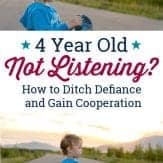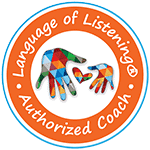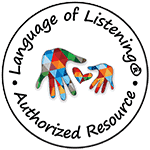Inside: Explore 7 common challenges with a 4 year old not listening. Learn simple solutions and resources to deal with 4 year old behavior.
I sat curled up in the oversized yellow chair. A blanket separated my legs from the cool surface of my laptop. The kids were asleep – finally.
And after the wildly chaotic day filled with rapid fire behavior challenges, all I could do was get curious about what was happening beneath the surface of my 4 year-old not listening.

There’s always a reason why a 4 year-old doesn’t listen.
Learning about kids’ brain development is fascinating, and more often than not, it gives a fresh perspective to separate your own emotions from your child’s behavior.
Inside the 4 year-old brain.
“The neurological processing in the 4 year old’s brain is twice as busy as that of a college student, and perhaps three times busier than an adult’s.
A preschooler has 100 billion brain cells (neurons), with 77 percent in the cerebral cortex — the territory that handles language, math, memory, attention, and complex problem solving. The neurons are forming connections via their dendrites, skinny octopus arms that slither out to receive information from up to potentially 15,000 other cells, and axons — which transmit information from neurons to other cells. The connections between neurons — called synapses — eventually total up between 1,000 trillion.” (source)
The daily result is massive mental exertion.
It’s not surprising that behavior challenges pop up around age four.
They are bombarded with explosions of information from every direction – all while working to develop important life skills like how to manage anger, self-control, manners and communication skills.
On top of that, behavior habits you don’t like that much are building from the toddlers years.
Think: 2 year old not listening, 3 year old not listening…it all can compound if unheard upsets build over time. Anything unresolved for both you and your child are now ever present in your day-to-day interactions.
Related:How to Help a Child Focus in the Classroom – 5 Things Parents Can Do
4 year old not listening? 7 challenge points with real solutions.
Your child isn’t so little anymore and things like back talk, defiance, anger, sibling issues, school anxiety, screen time and overall testing of boundaries show up robustly.
The good ole’ distraction technique rarely works, and most of the time intensifies the situation. Timeouts, threats and bribes never bring the cooperation you truly want. You are constantly exhausted.
When your 4 year old isn’t listening, here are 7 out of the box solutions to try.
1. Helping your child listen at preschool or daycare.
What happens at daycare or school is SO hard to deal with because you can’t exactly control what happens there. It can leave you feeling powerless as a parent. Especially when teachers and providers share with you that your child is aggressive, disrespectful or flat out not listening all day long.
While you can get a lot of information about what is happening from the teacher, and that is an important piece, there is one other thing I typically recommend to parents:
Role play at home to see what your child reveals to you.

How kids act during role play is often how they perceive the situation – whether it’s true or not – it is their reality and you can take them at their word.
Now you have something to work with and can start problem-solving solutions. Check out the posts below to learn how to get started.
Role play and school resources:
- How to use role play with preschoolers
- How to use play to end power struggles
- One powerful way to help your child conquer preschool anxiety
2. Gaining cooperation at bedtime.
Bedtime lends itself toward lots of chaos kids – whether it’s dealing with the onset of separation anxiety, or bad dreams, thoughts about their day or the difficulty of having to be self-controlled when they still have lots of energy.
You want bedtime to be calming and nurturing without the chaos.
This is one of those opportunities where it can really help to check in with YOURSELF, and get clear with what your boundaries are. That is, what you like and dislike about getting the kids to bed. What are you ok with and not ok with.
Getting clear on boundaries >>> The Big Reason Why Setting Limits With Your Strong Willed Child Isn’t Working.
Because…here’s the thing:
It’s really hard to help kids deal with their chaos when we’ve got our own. Knowing ahead of time what thoughts are swirling around at the back of your head in regards to bedtime (your own pressure to get them to sleep because it’s what’s “right” or the desperate thought of just needing your “me” time) will put you in the right place with the kids at bedtime.
You’ll be able to get to a place where you can achieve that nurturing calm, while holding your boundaries without nagging and truly enjoy your time together so you can all get a good sleep.
Bedtime resources and support:
- How to put a child to sleep fast – 7 key strategies
- How to respond when your child is afraid to sleep alone
- The real reason why kids never want to sleep – handling bedtime tantrums
- How to get your child to follow a bedtime routine without reminders
3. Ending the dinnertime battles.
Food is one of those things kids quickly learn that you cannot control. They are so clever in that way! As much as you want the broccoli in their stomachs, you can’t make them. Only the child can make it happen.
Anytime consistent food challenges show up, there are usually two things happening:
- Kids are feeling powerless, desire control and want to prove to that you cannot control this.
- Kids are wanting to connect with you, yearning to feel heard and understood from their point of view.
So what can you do?
The step of connection is so important. Without it, our guidance becomes white noise to kids and things escalate. Noticing what kids like and don’t like, especially at the dinner table, is a huge first step towards connection.
When comes to the table and looks disgusted, SAY WHAT YOU SEE® might sound something like…
“You don’t like the look of that. You’re frowning.”
And the child may come back and say, “Yeah, I don’t like the beans.”
Now you have something to work with and you can say, “You don’t like those beans at all! Sounds like you’re okay with the salad and chicken.”
Since being allowed to say what she doesn’t like prevents the need to act it out or prove it, that could be all it takes for her to move into cooperation about the rest of the meal. She might even tell you what she wished she could eat like, “I wish we were having spaghetti,” to which you would respond, “Of course you do. You love spaghetti, and this is what we have. Rats! It’s not what you want.”
Validating what she likes instead of taking it personally would allow her to come back with, “It’s okay. Chicken and salad are okay, too,” and skip off, happy to have been heard. Honestly, that’s how kids work!
Worst case scenario…
The child may come back and say, “No, I don’t like the salad or the chicken. It’s all YUCK.” That would tell you that the child is still fighting old battles and expecting no one to care what she wants, or worse, expecting that she will be made to eat things she doesn’t want.
Carrying on and on about foods she doesn’t like, proving that she’s right not to like it, even after you validate her, simply means she needs to be validated even more to feel heard. That might sound like, “Oh, no! It’s all yucky, and that’s what we have. This is not the dinner you want at all! Push the plate toward the middle of the table so it’s not so close to you.”
The good news is this is not a personal assault on your cooking ability! It’s your child practicing and learning what she likes and doesn’t like and hoping that someone will hear her.
More resources to create a peaceful dinnertime:
- A simple mealtime hack that will get your child to eat vegetables
- An easy change to help end dinner time battles
- What and how much should a child eat? Advice from a pediatrician
- 7 foods that support better behavior in kids
- Why you should avoid the Clean Plate Club and what to do instead
4. Navigating sibling rivalry and sibling jealousy.
No matter the reason siblings say they “don’t like each other” there is always something deeper beneath those words. In the simplest terms, siblings not liking each other often boils down to two things: having to share their world with a sibling…and favoritism.
Kids are absolutely positively sure that everything that was once theirs is now ruined by their sibling. They may also believe that you love and favor their sibling more than them. This is very real for kids.
And that’s not even the worst part.
What’s worse is when you try to tell a child, “Of course you love your sister,” or “It’s not okay to say you don’t like someone,” or “You don’t hate your brother. I know that’s not true,” the disconnect widens.
Kids will dig their heels in even more and try to prove you wrong. They’ll try to prove to you that their feelings are very real. That they really, really, really never wanted a sister. Or that you really, really, really do love their sibling more than them.
Staying neutral with your kids and sportscasting between them – taking the kids at their word – can be a great first step into resolution.
Check out these sibling rivalry resources:
- How to stop sibling jealously
- How to help siblings get along
- Siblings without rivalry: How to help your children live together so you can live too
5. Helping your 4 year old with back talk and defiance.
There are times when kids feel “trapped in a cage,” and there is seemingly no path out. In their deep desire to feel heard, kids who feel trapped will act out using the only power tools they know – the ones they learn from adults: They scream, yell, argue, boss or punish.
Acting out is the child’s way of communicating. A child who is doing those things is actually trying to get you to understand that he is right to feel the way he does and wishes you could see past his actions to the person he is underneath.

If you only hear, see and react to the disrespectful behavior (symptoms of an underlying problem) instead of the message – “I want you to understand who I really am!” – the child will have no choice but to escalate his message or disconnect from you completely.
If you’re able to get to the bottom of kids’ communications, they will feel very understood and accepted. This allows kids to move out of the “trapped in a cage” feeling, away from the back talk and disrespect, and into a place of cooperation. When kids trust and feel safe, they will start to grow and surprise you in the most amazing ways.
Resources to help you end back talk and disrespect:
- 4 year old talking back? How to stop the sass and create peace with two techniques
- How to handle back talk and disrespect like a calm and steady parenting warrior
6. Not listening with overall testing of boundaries.
Strong-willed kids are often seen as defiant or rebellious because grown ups say one thing and the kids do the complete opposite or they seem to struggle immensely with boundaries.
If you’re able to see strong-willed kids in a completely different light, what you actually have on your hands is a child who is very self-directed and a child who has been trying to create his own boundaries for a long time. This can lead to a lot of chaos and missed communications.
Strong willed kids are typically fine with boundaries (how a grown up likes or doesn’t like things), and what they are actually struggling with is the rule (one of the million different ways to help the child bounce from our preferences / boundaries and find a way to meet their own needs of power, experience and connection).
Resources to help your child cope with boundaries:
- The key to setting limits with a strong-willed child
- Dealing with controlling kids: The “secret sauce” for gaining cooperation
7. When anger and aggression show up.
Everything children say and do is a communication. They absolutely must continue to communicate until heard. This is human nature; so if kids don’t get to express themselves, they will either escalate their actions now or store it up for later.
When unheard upsets build, kids will turn to aggressive and challenging behaviors to show you instead.
These behaviors can be seen as a cry for help.
Things can escalate quickly if missed communications build over time. When parents or caregivers try to stop or scare kids out of angry and aggressive behavior, kids may try to prove that their upsets are very real by further intensifying their behaviors.
Angry kids are experiencing a whole lot of hurt and anguish and the simplest way to help them calm down is to help them feel heard and understood. (Remember: Understanding your child’s point of view is not the same as agreeing with it or condoning a behavior.)
Step-by-step guides for dealing with anger and aggression in kids:
- Why is my child so angry and aggressive
- The number one reason toddler aggression is still showing up
- The easiest way to deal with a child who hits, kicks or bites
Print this free listening checklist.
This post comes with a free printable checklist to help with listening. I always have the hardest time remembering these phrases. This printable simplifies it!
Here is a sneak preview…
Download Your Free Printable
- Download the checklist. You’ll get the printable, plus join 37,000+ parents who receive my weekly parenting tips and ideas!
- Print. Any paper will do the trick, but card stock
would be ideal.
- Place it on your refrigerator. Check things off as you go and don’t forget a thing!
Want more on parenting?
- The Most Powerful Way to Respond When Your Child Feels Rejected
- Boundaries, Routines and Early Bedtimes: 13 Habits That Raise Well-Adjusted Kids
- The Most Overlooked Reason Why Kids Won’t Listen
- One Genius Phrase Every Parent Needs When Kids Say, “I Can’t.”
- 10 Powerful Phrases When Your Child Whines or Complains
- Parenting Anger: How to Help Yourself Cope When You’re Triggered
I've created a free email series just for you! If you are struggling with teaching your child to listen, this series will help transform your parenting. Yes, really. I've seen my proven strategies work time and time again for parents. I know it can work for you too.
After taking my free email series, you will:
- Learn simple, yet highly effective listening strategies
- Experience a stronger connection with your child
- Enjoy more peaceful parenting days
- Gain more cooperation from your child














Hi, Lauren
It’s so difficult to deal with what happens at daycare or school because can’t exactly monitor what happens there. It can leave as a mom, feeling helpless. Great post.
Thank
Hi! Thanks for the article but there were a couple of things I wanted to understand better.
Could you please explain this sentence?: Strong willed kids are typically fine with boundaries (how a grown up likes or doesn’t like things), and what they are actually struggling with is the rule (one of the million different ways to help the child bounce from our preferences / boundaries and find a way to meet their own needs of power, experience and connection).
And also, the following paragraph was terrifying to read…could you please indicate how we are supposed to get to the bottom of how they are feeling and “who they really are?”: If you only hear, see and react to the disrespectful behavior (symptoms of an underlying problem) instead of the message – “I want you to understand who I really am!” – the child will have no choice but to escalate his message or disconnect from you completely.
Thanks!